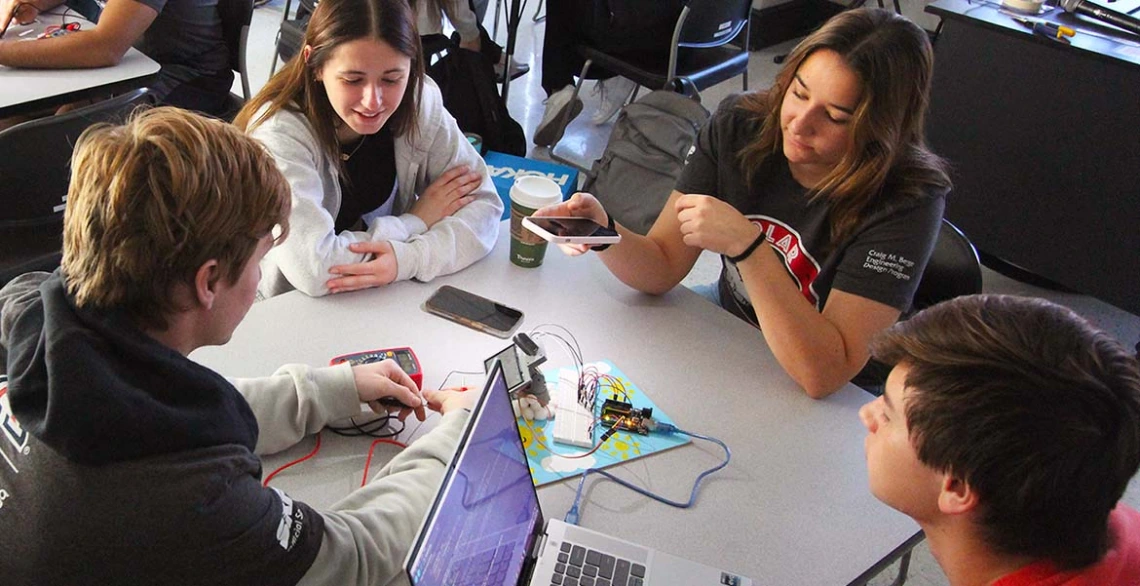Solar Track Meet Infuses Even More Design Into First Year
First-year students quickly regroup for a second experiential project as part of the Craig M. Berge Engineering Design Program.

Students test their solar tracker in the classroom.
As the smoke cleared from the Solar Oven Throw Down, first-year students teamed up again for another hands-on project as part of the Craig M. Berge Engineering Design Program. For the college’s new Solar Track Meet, students became certified in 3D printing and built autonomous trackers that follow the sun’s movements to maximize collection of solar energy.
“The first semester is design-heavy. We give students these opportunities as soon as they walk into the university,” said Umar Amjad, lead instructor for the ENGR 102 classes required for incoming students. Each class held its own meet.
Salt River Project sponsored the initiative as part of its partnership with the college, which also includes sponsorship of student clubs and Craig M. Berge Design Day.
“SRP is a community-based organization that understands the value of education to our community. This especially applies to the STEM competencies that play a key role in innovation and solving problems,” said Andrea Moreno, SRP Community Stewardship Program Manager.
First, We Print
The project began with students learning to 3D print supporting components for their trackers. Each student had to pass a certification class at CATalyst Studios in the University of Arizona Main Library.
The certification will serve students beyond the Solar Track Meet and even outside school, said Amjad.
“This is recognition when they apply for internships or jobs that they have real experience designing something on a computer and physically printing it.”
Student Brooke Hesse is pleased she learned the skill early in her time at the College of Engineering.
“It’s a cool skill to have, engineer or not. It could be beneficial in a lot of different aspects,” she said.
Then, We Build and Track
For Hesse, completing two design projects in her first semester has been her favorite part of joining the college. Her teammate Tatum Abbruscato agreed, saying: “It feels like being an engineer when you get to have your hands on a circuit.”
Hesse, Abbruscato and their teammate William Bornmann found that small details, such as the resistance value of their photoresistors, mattered when constructing the tracker.
“We had to try out a bunch of different kinds. Even the size of our 3D printed parts mattered to make sure they would fit,” said Abbruscato.
Taking on this subject matter is confidence-building and relevant for the students, Amjad said.
“This project builds nicely on the Solar Oven Throw Down. Students now need to optimize by deciding where to place the solar panel. Whatever these students do in the future, it’s beneficial for them to learn this now. Autonomous systems are the future,” he said.
The instructional style appeals to SRP, said Chris Campbell, the organization’s senior director of distribution and technology operations.
“The program is very appealing given the experiential learning aspects of hands-on projects and the opportunity for practical application of learned knowledge,” said Campbell, who serves on the college’s Industry Partner Board.
Extending the SRP Legacy
SRP is interested in continuing the long history of University of Arizona engineering alumni working at SRP, said Campbell. SRP’s general manager and CEO, Mike Hummel, was named the college's alumnus of the year at Homecoming 2022.
Sponsorship and engagement help SRP develop and recruit its future workforce.
“Supporting the university and the Solar Tracker project is definitely worth the investment,” said Employee Experience Manager Vy Kieu. “Recruiting skilled workers will always be challenging, but being able to engage with students early in their college career is an important strategy to developing a thriving workforce at SRP.”

